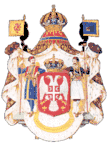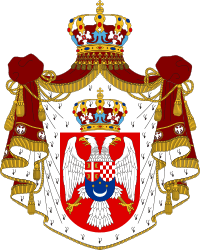Serbian heraldry
The use of heraldry in Serbia or by Serbs is used by government bodies, subdivisions of the national government, organizations, corporations and by families. Serbian heraldry belongs culturally to the Byzantine tradition.
.jpg) White double-headed eagle of Nemanjići | |
| Heraldic tradition | Central and Eastern European heraldry |
|---|---|
| Governing body | Serbian Heraldry Society |
As in some other European heraldic traditions, the most prominent among the animals is the eagle.
The most prominent symbols is the Serbian eagle and the Serbian cross.
Background
Medieval Serbian legacy

The double-headed eagle and the Serbian cross are the main heraldic symbols which represent the national identity of the Serbian people across the centuries.[1]
Illyrian Armorials
Habsburg and Austro-Hungarian heraldry
Serbian nobility in the Habsburg Monarchy and Austria-Hungary, upon receiving noble status, adopted coat of arms, often influenced by the Illyrian Armorials.
History
Revolutionary Serbia
The war flags of the first and second Serbian uprisings (1804–1815) are in several types.
The seal of the Serbian parliament had the Serbian cross and the Triballi boar.
Serbian monarchy
Socialist Yugoslavia

Derived from the traditional shield of arms of Serbia with 4 fire steels (but without the cross). The Serbian cross was removed for ideological reasons of socialist atheism. It was placed above a rising sun with a cog wheel symbolizing the workers and surrounded with a golden wreath of maize and oak leaves, oak being a sacred Serbian tree. A red ribbon with dates 1804 and 1941 which refer to the dates of the first Serbian uprising against the Ottomans and the national uprising against the axis powers in the Second World War.
Contemporary heraldry
Republika Srpska & Federal Republic of Yugoslavia that broke up into Republic of Serbia & Republic of Montenegro.

 Republika Srpska (1992-2007)
Republika Srpska (1992-2007)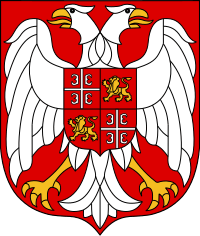 Federal Republic of Yugoslavia.
Federal Republic of Yugoslavia..svg.png) Republic of Serbia (2004-2010)
Republic of Serbia (2004-2010)
Coat of arms of Serbia
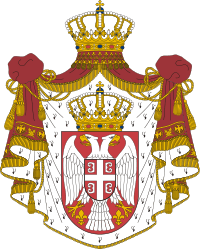
The modern coat of arms is derived from the Obrenović dynasty coat of arms, which drew influence from the medieval Nemanjić dynasty. The principal field stands for the Serbian state. It consists of a double-headed (bicephalic) eagle on a red shield; its body and wings in silver, and tongues, beaks, legs and claws in gold, between two golden fleurs-de-lys. The inescutcheon stands for the Serbian nation; in a red shield, a cross between four silver firesteels arranged in the quarters around it, all of them facing horizontally outwards.
Although Serbia is now a republic, the new coat of arms also features the crown of the former Serbian monarchy. While unusual for republics, it is not unprecedented, as can be seen with the Republic of San Marino (San Marino adopted a new crown to represent its sovereignty, and did not usurp a crown of a past sovereign).
Coat of arms of municipalities and cities
|
|
|
Common symbols
The double-headed eagle and the Serbian cross are the main heraldic symbols which represent the national identity of the Serbian people across the centuries.[1] Both the eagle and cross were adopted from the Byzantine Empire, and are today part of the Coat of arms of Serbia. The double-headed eagle was used by the Nemanjić dynasty.[1]
Another common symbol is the Triballian boar, depicting the head of a boar pierced by an arrow.[2] It was used for historical Serbia in numerous armorials dating between the 15th and 18th centuries. It was adopted by Karađorđe[3] into the seal of the Revolutionary Serbian government, alongside the Serbian cross.[4]
 The Serbian eagle as seen in a modern stylized Nemanjić dynasty coat of arms.
The Serbian eagle as seen in a modern stylized Nemanjić dynasty coat of arms. The Serbian cross as seen in the "shield" of the official coat of arms.
The Serbian cross as seen in the "shield" of the official coat of arms.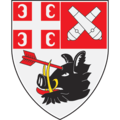 The Triballian boar as seen in the Kragujevac coat of arms.
The Triballian boar as seen in the Kragujevac coat of arms.
St. George and the Dragon, a symbol of courage and valor and the triumph of Good over Evil, is used in the coat of arms of Srpski Krstur. The severed Turk head, in reference to the wars with the Ottoman Empire, is used on the coat of arms of Kikinda and Vršac.
Popular elements in modern heraldry include the Serbian tricolour, nature, such as oak, olive, wheat, plum, grape; weapons, such as sword, cannon, gun, arrows.
See also
| Wikimedia Commons has media related to Serbian coat of arms. |
References
- Atlagić 2009, p. 180.
- Danko Popović; Dinko Davidov (2004). Studije o srpskoj umetnosti XVIII veka. Српска књижевна задруга. p. 18.
- Vanja Kraut; Miodrag Đorđević; Rade Rančić (1985). Istorija srpske grafike od XV do XX veka. Narodni muzej. p. 73.
- SANU (1957). Posebna izdanja. SANU. p. 130.
Further reading
- Acović, Dragomir (2012) [2008]. Heraldika i Srbi. Zavod za udžbenike. ISBN 978-86-17-15093-6.
- Atlagić, Marko (1997). "The cross with symbols S as heraldic symbols" (PDF). Baština. 8: 149–158. Archived from the original (PDF) on 21 May 2013.CS1 maint: ref=harv (link)
- Atlagić, Marko (2007). "Печати Карађорђеви и његових првака у Првом српском устанку" (PDF). Зборник радова Филозофског факултета. Филозофски факултет у Приштини. 37.
- Atlagić, Marko (2009). "Određivanje nacionalnih heraldičkih simbola na primjeru Srba i Hrvata" [Étude des symboles nationaux héraldiques à l' exemple des Serbes et des Croates] (PDF). Zbornik radova Filozofskog fakulteta u Prištini. 39: 179–188.CS1 maint: ref=harv (link)
- Ivanišević, Vujadin (2004). "Razvoj heraldike u srednjovekovnoj Srbiji" [The development of heraldry in medieval Serbia] (PDF). Zbornik radova Vizantološkog instituta. 41: 213–234.
- Ivanišević, Vujadin (2001). Новчарство средњовековне Србије. Belgrade.
- Ivić, Aleksa (1910). Stari srpski pečati i grbovi: prilog srpskoj sfragistici i heraldici. Natošević.CS1 maint: ref=harv (link)
- Ivić, Aleksa; Mrđenović, Dušan; Spasić, Dušan; Palavestra, Aleksandar (1987). Rodoslovne tablice i grbovi srpskih dinastija i vlastele. Belgrade: Nova knjiga.
- Milićević, Milić (1995). Grb Srbije: razvoj kroz istoriju. Službeni glasnik.CS1 maint: ref=harv (link)
- Novaković, Stojan (1884). "Хералдички обичаји у Срба: у примени и књижевности". Београд: Краљевско-српска државна штампарија. Archived from the original on 22 April 2015.
- Odak, Marina I. (2015). "Ikonografija i simbolika predstava na srpskom srednjovekovnom novcu". Belgrade: Filozofski fakultet.CS1 maint: ref=harv (link)
- Palavestra, Aleksandar (June 1998). "O ocilima" (PDF). Glasnik SHD (in Serbian). Archived from the original (PDF) on 29 October 2013.CS1 maint: ref=harv (link)
- Palavestra, Aleksandar (2010). Ilirski grbovnici i drugi heraldički radovi. Belgrade: Dosije studio.CS1 maint: ref=harv (link)
- Solovjev, Aleksandar Vasiljevič (1958). Istorija srpskog grba. Srpska misao.CS1 maint: ref=harv (link)
- Stanojević, Stanoje (1934). "O srpskom grbu". Iz naše prošlosti. Belgrade: Geca Kon A. D. pp. 85–90.CS1 maint: ref=harv (link)
- Pavlović, Milijvoje (2007). "Grbovi starog i novog doba". Srpska znanja: zvuci, boje, oblici. Belgrade: Čigoja. pp. 15–23.CS1 maint: ref=harv (link)

